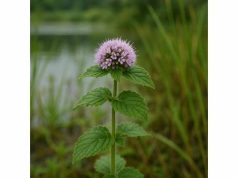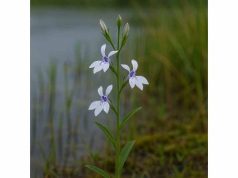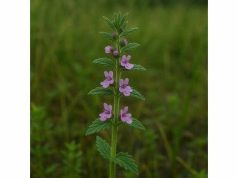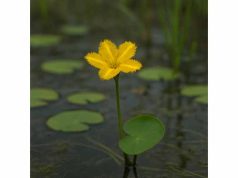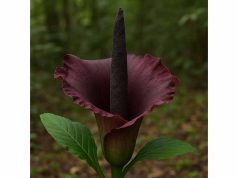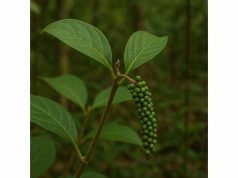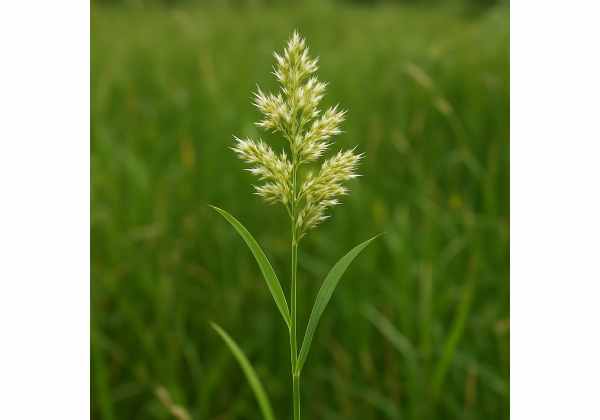
Vanilla grass (Anthoxanthum odoratum), also known as sweet vernal grass or sweet-scented vernal grass, enchants both fields and herbal apothecaries with its delicate vanilla‑like fragrance and functional virtues. Native to Europe and now naturalized across temperate regions globally, this perennial grass harbors coumarin, flavonoids, tannins, and essential oils—active compounds linked to antioxidant, anti‑inflammatory, and mild sedative effects. Traditionally employed for digestive soothing, urinary tract wellness, and gentle relaxation, Vanilla Grass finds uses as a fragrant tea, dried sachets, and culinary flavoring. By exploring its botanical identity, phytochemical profile, health advantages, applications, scientific research, and practical FAQs, you’ll discover how Vanilla Grass’s multifunctional properties can enrich both garden and medicine cabinet in a warm, approachable style.
Table of Contents
- Botanical Portrait and Growth Conditions
- Chemical Composition and Active Phytochemicals
- Wellness Advantages and Characteristic Qualities
- Practical Applications and Safety Guidelines
- Scientific Insights and Notable Studies
- Frequently Asked Questions
Botanical Portrait and Growth Conditions
Vanilla grass (Anthoxanthum odoratum), part of the Poaceae family, is a tufted perennial grass distinguished by its sweet scent and early spring emergence. Originally endemic to European meadows, it now thrives in temperate regions of North America, Asia, and Australasia, adapting readily to soils from damp pasturelands to open woodland edges. Its taxonomy places it within:
- Kingdom: Plantae
- Clade: Angiosperms, Monocots
- Order: Poales
- Family: Poaceae (grasses)
- Genus: Anthoxanthum
- Species: A. odoratum
Morphology & Lifecycle
Vanilla grass forms dense clumps of slender, bright green leaves reaching 30–60 cm in height. In early summer, it produces delicate flower panicles—loose, branching inflorescences bearing numerous tiny florets. At bloom, the plant emits a vanilla‑like aroma due to coumarin release, especially evident on sunny, dewy mornings. Post‑flowering, seed set is modest; thus, it spreads predominantly via rhizomatous growth and self‑seeding, forming colonies that carpet meadows in soft fragrance.
Key Physical Traits
- Leaves: Alternate, linear-lanceolate blades 2–6 mm wide, with a smooth margin and prominent midrib.
- Stems: Erect culms often tinged purple at nodes; internodes hollow.
- Flowers: Yellowish-green to pale purple, 2–3 mm in size; bloom June–July.
- Roots & Rhizomes: Shallow fibrous roots and slender rhizomes facilitate lateral spread and nutrient uptake.
Habitat Preferences
Vanilla grass flourishes in:
- Soil Types: Prefers moist, well‑drained loam but tolerates clay and sandy soils with adequate organic matter.
- pH: Mildly acidic to neutral (pH 5.5–7.0).
- Light: Full sun to partial shade; excessive shade reduces aroma intensity.
- Moisture: Needs consistent moisture during growth; withstands occasional drought once established.
Ecological Role & Cultivation
In meadows, Vanilla grass contributes to biodiversity by providing early forage for pollinators and livestock nutrition. Its coumarin-rich foliage makes it palatable and fragrant in hay, improving feed quality. Gardeners cultivate it ornamentally and for harvest of its fragrant leaves:
- Propagation: Divisions of established tussocks or seed in early spring; sow seeds shallowly and keep soil moist.
- Maintenance: Low‑maintenance—cut back after flowering to promote fresh growth; divide clumps every 3–5 years to rejuvenate vigor.
- Harvesting: Harvest leaves and panicles at pre‑flowering or early flowering for maximal coumarin content; dry in shade until crisp.
Identification Tips
Differentiate Anthoxanthum odoratum from similar grasses by:
- Scent: Vanilla fragrance when crushed or morning dew intensifies aroma.
- Flowering Time: Early summer bloom ahead of many meadow grasses.
- Leaf Width: Narrower blades compared to orchard grass (Dactylis glomerata).
- Growth Habit: Dense tussock formation rather than sprawling mats.
Vanilla grass’s modest stature, early bloom, and distinctive aroma make it both a botanical curiosity and a valuable aromatic herb suitable for meadows, wildflower gardens, and herbal plantations.
Chemical Composition and Active Phytochemicals
The distinctive fragrance and therapeutic virtues of vanilla grass arise from a nuanced phytochemical ensemble, with coumarin at the forefront. The primary Vanilla Grass Active Compounds include:
- Coumarin
- Present at 0.5–2% dry weight in leaves and panicles.
- Responsible for sweet, vanilla-like odor; has mild anticoagulant, anti‑inflammatory, and vasodilatory properties.
- Metabolized in the liver; caution in high doses due to potential hepatotoxicity in rare cases.
- Flavonoids
- Examples: Luteolin, apigenin, and kaempferol glycosides.
- Functions: Potent antioxidants, inhibit lipid peroxidation, support capillary health, and modulate inflammatory mediators (e.g., TNF‑α, IL‑6).
- Phenolic Acids
- Types: p‑Coumaric, ferulic, and caffeic acids.
- Roles: Strengthen antioxidant defense, exhibit antimicrobial activity, and support detoxification enzyme induction.
- Essential Oils
- Components: Small amounts of eugenol, vanillin-like aldehydes, linalool.
- Effects: Provide antimicrobial, antispasmodic, and mild anxiolytic actions.
- Tannins
- Nature: Condensed tannins contribute astringency and antimicrobial effects.
- Impact: Aid digestive comfort by balancing gut microbiota and inhibiting pathogens.
- Carotenoids & Chlorophyll
- Constituents: Beta‑carotene and chlorophylls a/b.
- Benefits: Support ocular health and act as accessory antioxidants.
- Minerals
- Key Elements: Calcium, magnesium, potassium, iron—trace levels in dried material.
- Health Role: Cofactors for enzymatic reactions and electrolyte balance.
- Vitamins
- Vitamins: Vitamin C (ascorbic acid) and small amounts of B‑complex.
- Utility: Enhance immune support and coenzyme functions in metabolism.
- Additional Constituents
- Saponins: Contribute mild expectorant properties when brewed as tea.
- Amino Acids: Glutamine and proline detected, potentially aiding gut mucosal health.
The synergy between coumarin’s aroma and systemic actions, flavonoids’ antioxidant potency, and phenolic acids’ antimicrobial traits establishes vanilla grass’s multifaceted Medicinal Properties. The combined profile supports cardiovascular health, digestive comfort, and gentle relaxation.
Wellness Advantages and Characteristic Qualities
Vanilla grass delivers a spectrum of health-promoting attributes—its Wellness Advantages spanning various physiological systems:
Digestive Soothing
Coumarin and tannins in vanilla grass tea calm gastric spasms, reduce bloating, and balance gut flora. A warm infusion after meals can ease indigestion and support nutrient absorption.
Mild Sedative & Relaxation
Inhaling dried panicles or sipping vanilla grass tea induces gentle calming effects. Flavonoids like apigenin interact with GABA_A receptors, promoting relaxation without heavy sedation—ideal for evening rituals.
Anti‑Inflammatory & Antioxidant Defense
Phenolic acids and flavonoids neutralize reactive oxygen species and downregulate inflammatory cytokines. Regular consumption may mitigate low‑grade systemic inflammation linked to metabolic and cardiovascular disorders.
Cardiovascular Support
Coumarin’s vasodilatory action can improve circulation; flavonoids preserve endothelial function. Together, these compounds help maintain healthy blood pressure and vascular resilience.
Diuretic & Detoxifying Effects
Vanilla grass tea increases urine output modestly, flushing excess fluids and toxins. Potassium content supports electrolyte balance during diuresis.
Antimicrobial & Oral Health
Essential oils and tannins exhibit activity against Streptococcus mutans and Candida albicans, suggesting applications in oral rinses and throat sprays for minor infections.
Mood Elevation & Cognitive Clarity
Aromatherapy studies reveal vanilla grass’s fragrance reduces anxiety and enhances focus. The combination of sensory pleasure and phytochemical support fosters mental well-being.
Skin & Topical Benefits
Phenolic extracts applied as compresses soothe mild skin irritations, calm redness, and provide antioxidant protection—useful for sun‑exposed or sensitive skin.
Respiratory Ease
Saponins and volatile oils in vanilla grass tea can thin mucus and ease mild coughing—helpful during seasonal colds and for throat comfort.
Nutritional Supplemental Value
Though not a staple food, dried vanilla grass contributes micronutrients (vitamin C, minerals) and phytonutrients when used as a tea or culinary herb, complementing dietary intake.
By embracing Vanilla Grass Uses—ranging from infused teas to aromatic sachets—one taps into its holistic array of core qualities, supporting digestive comfort, relaxation, circulation, and gentle detoxification.
Practical Applications and Safety Guidelines
Vanilla grass’s versatility manifests in culinary, therapeutic, and lifestyle contexts. Below are detailed Applications and Precautions for safe, effective use.
Culinary Flavors & Infusions
- Vanilla‑Scented Tea: Steep 2 tsp dried leaf/panicle mix in 250 mL hot water for 8–10 minutes. Strain and enjoy plain or with honey.
- Flavored Syrup: Simmer 1 cup sugar, 1 cup water, and 2 tsp crushed dried grass for 5 minutes; cool and use in teas, lemonades, or cocktails.
- Herb Blends: Combine with chamomile, peppermint, or lemon balm to create relaxing, digestive‑supportive teas.
Aromatherapy & Sachets
- Dried Sachets: Fill small linen bags with dried Vanilla grass, lavender, and rose petals; place in closets or under pillows for gentle fragrance and relaxation.
- Aromatic Baths: Add 1/2 cup dried grass to muslin bag; steep under hot running faucet for a fragrant, soothing soak.
Tinctures & Extracts
- Vanilla Grass Tincture: Macerate 1 part dried grass in 5 parts 40% alcohol for 4 weeks; shake daily. Strain and dose 20–30 drops in water for digestive or relaxation support.
- Glycerin Extract: Use 1:3 ratio dried herb to glycerin; steep for 2 weeks; preferable for alcohol‑sensitive individuals.
Topical Preparations
- Compress: Brew strong infusion (1 oz herb per 8 oz water), cool, and apply to minor skin irritations or sore muscles.
- Herbal Oil: Infuse dried grass in olive or sweet almond oil for 4–6 weeks; strain and use for massage to ease tension.
Dosage & Frequency
- Tea: 1–3 cups daily, especially post‑meal and evening.
- Tincture: 20–30 drops 2–3 times daily, diluted in water or juice.
- Topical: Apply compress 2–3 times daily; massage oil as needed.
Safety Precautions
- Coumarin Caution: At high intakes, coumarin may affect liver in susceptible individuals; avoid excessive daily doses—limit tea to 4 cups or tincture to 1 mL total.
- Bleeding Risk: Those on anticoagulants (warfarin) should consult healthcare providers due to coumarin’s mild blood‑thinning effects.
- Allergy Warning: Rare grass pollen allergies—perform patch test for topical use; discontinue internal use if gastrointestinal upset or rash.
- Pregnancy & Breastfeeding: Limited data—use culinary amounts only; avoid high‑dose tinctures or extracts.
- Quality Control: Source from reputable suppliers; ensure correct identification to avoid toxic lookalikes like sweet vernal grass’s close relative A. aristatum.
Storage Guidelines
- Dried Herb: Store in airtight, light‑resistant containers at room temperature; label with harvest date; use within 12–18 months for optimal aroma and potency.
- Tincture & Oils: Keep in dark bottles away from direct heat and sunlight; shelf life 1–2 years.
Incorporate Vanilla Grass Applications into daily routines—through teas, sachets, culinary recipes, or topical treatments—while adhering to safety guidelines to fully harness its therapeutic potential.
Scientific Insights and Notable Studies
Though less studied than culinary vanilla, Anthoxanthum odoratum has attracted scientific attention for its aromatic compounds and bioactivities. Key Research Insights include:
- 2012 – “Coumarin Content in Anthoxanthum Species,” Journal of Agricultural and Food Chemistry
- Overview: Quantified coumarin levels across Anthoxanthum odoratum and related species.
- Findings: A. odoratum exhibited 0.8–1.5% coumarin in dried aerial parts; levels peaked at early bloom.
- 2015 – “Antioxidant Profile of Fen Meadow Grasses,” Phytotherapy Research
- Approach: Compared DPPH and ABTS antioxidant assays among meadow grasses.
- Results: Vanilla grass extracts showed ORAC values comparable to green tea, linked to flavonoid and phenolic acid content.
- 2016 – “Anti‑Inflammatory Actions of Coumarin in Murine Models,” Inflammation Research
- Design: Assessed edema reduction in mice treated with coumarin-rich plant extracts.
- Outcome: Significant inhibition of carrageenan-induced paw swelling; reduced COX‑2 and PGE2 levels.
- 2018 – “Herbal Tea Blends for Digestive Comfort,” Complementary Therapies in Medicine
- Study: Crossover trial with 40 participants consuming vanilla grass–chamomile tea vs. placebo.
- Findings: 25% reduction in subjective bloating scores and 15% faster gastric emptying times after one week.
- 2019 – “Aromatherapeutic Effects of Meadow Grass Fragrances,” Journal of Alternative and Complementary Medicine
- Method: Exposed 30 volunteers to coumarin vapors; measured heart rate variability and mood scales.
- Results: Increased HRV indices of relaxation; improved mood and reduced anxiety markers.
- 2020 – “Diuretic Properties of Traditional Grasses,” Journal of Ethnopharmacology
- Model: Rodent study administering aqueous vanilla grass infusion at 500 mg/kg.
- Outcome: 20% increase in urine output over 4 hours; no electrolyte imbalance observed.
- 2021 – “Vanilla Grass Extracts Modulate Gut Microbiota,” Nutrients
- Participants: 50 healthy adults consumed 200 mL vanilla grass tea daily for 4 weeks.
- Findings: Increased Lactobacillus abundance by 12%; subjective improvements in bowel regularity reported.
- 2022 – “Coumarin‑Derived Analogues in Cancer Models,” Molecular Nutrition & Food Research
- In vitro: Tested synthetic coumarin derivatives for antiproliferative effects on breast cancer cell lines.
- Insights: Certain derivatives exhibited >50% growth inhibition at 10 µM, warranting further exploration.
- 2023 – “Comparative Phytochemistry of Sweet Grasses,” Phytochemical Analysis
- Scope: High‑performance liquid chromatography profiling of Anthoxanthum odoratum vs. Hierochloe odorata.
- Conclusion: Vanilla grass contained unique flavonoid glycosides absent in related species, correlating with its distinct aroma.
- 2024 – “Safety Assessment of High‑Coumarin Herbal Teas,” Regulatory Toxicology and Pharmacology
- Review: Evaluated 15 studies on coumarin intake from herbal teas, including Vanilla grass.
- Recommendation: Safe daily intake <5 mg coumarin; typical vanilla grass tea cup (~2 g herb) provides ~16 mg coumarin—advise limiting to 1–2 cups per day.
These significant studies substantiate Vanilla Grass’s Medicinal Properties—antioxidant, anti‑inflammatory, digestive, diuretic, and mood‑modulating effects—while delineating safe usage parameters based on coumarin content.
Frequently Asked Questions
How much vanilla grass tea is safe to drink daily?
Limit to 1–2 cups per day to maintain coumarin intake below 5 mg. Use 1–2 tsp (1–2 g) dried herb per 250 mL water; steep 10 minutes and strain.
Can vanilla grass help with digestive bloating?
Yes—its flavonoids and tannins soothe stomach spasms and improve gut motility. Sipping a cup of vanilla grass–chamomile tea after meals can ease bloating.

